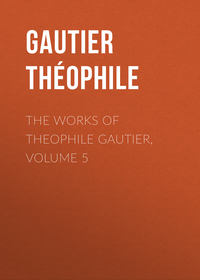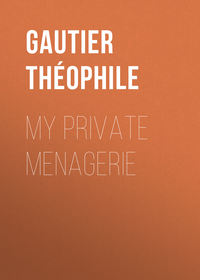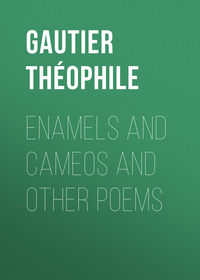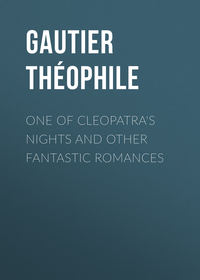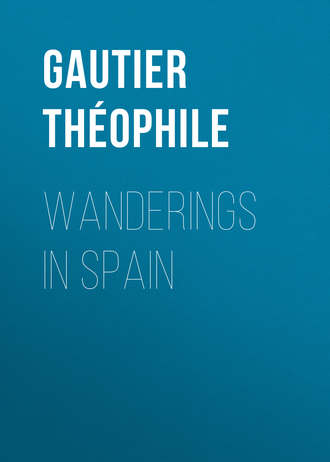 полная версия
полная версияWanderings in Spain
The choir, in which are the stalls, called in Spanish silleria, is enclosed by gates of wrought iron of the most wonderful workmanship; the pavement, as is the custom in Spain, is covered with immense mats made of spartum, besides which, each stall has its own little carpet of dry grass or reeds. On looking up, you perceive a kind of dome formed by the interior of the tower to which I have before alluded. It is one mass of sculptures, arabesques, statues, columns, nerves, and pendentives, sufficient to make your brain turn giddy. Were a person to gaze for two years, he still would not be able to see everything in it. The various objects are as densely crowded together as the leaves of a cabbage; there is as much open work as in a fish-slice; it is as gigantic as a pyramid, and as delicate as a woman's earring. How such a piece of filigree work can have remained erect during two centuries surpasses human comprehension! What kind of men could those have been who raised these marvellous buildings, which not even a fairy palace could ever surpass in profuse magnificence? Is the race extinct? Are not we, who are always boasting of our high state of civilization, but decrepit barbarians in comparison? I am always oppressed with a profound sentiment of melancholy whenever I visit any of these prodigious edifices of the past; my heart is overwhelmed by a feeling of utter discouragement, and the only wish I have is to withdraw to some retired spot, to place a stone upon my head, and, in the immovability of contemplation, to await death, which is immovability itself. Why should I work? Why should I exert myself? The most mighty effort of which man is capable will never produce anything more magnificent than what I have just described; and yet we do not even know the name of the divine artists to whom we owe it; and, if we wish to obtain the slightest information concerning them, we are obliged to seek it in the dusty leaves of the monastical archives. When I think that I have spent the best part of my life in making ten or twelve thousand verses, in writing six or seven wretched octavo volumes, and three or four hundred bad articles for the newspapers, and that I feel fatigued with my exertions, I am ashamed of myself and of the times in which I live, when so much exertion is required in order to produce so little. What is a thin sheet of paper compared to a mountain of granite?
If the reader will take a turn with me in this immense madrepore, constructed by the prodigious human polypi of the fourteenth and fifteenth centuries, we will commence by visiting the little sacristy, which, notwithstanding its name, is a very good-sized room, and contains an "Ecce Homo" and a "Christ on the Cross" by Murillo, as well as a "Nativity" by Jordäens. It is lined with the most beautifully carved woodwork. In the middle is placed a large brazero, which serves to light the censers, and perhaps the cigarettes also, for many of the Spanish priests smoke, a practice that does not strike me as being more unbecoming than that of taking snuff, in which the French clergy indulge, without the slightest scruple. The brazero is a large copper vessel, placed upon a tripod, and filled with burning embers, or little fruitstones covered with fine cinders, which produce a gentle heat. In Spain, the brazeros are used instead of fireplaces, which are very rare.
In the great sacristy, which is next to the little one, the visitor remarks a "Christ on the Cross" by Domenico Theotocopuli, surnamed El Greco, an extravagant and singular painter, whose pictures might be mistaken for sketches by Titian, if there were not a certain affectation of sharp and hastily-painted forms about them, which causes them to be immediately recognised. In order that his works may appear to have been painted with great boldness, he throws in, here and there, touches of the most inconceivable petulance and brutality, and thin sharp lights which traverse the portions of the picture which are in shadow, like so many sword-blades. All this, however, does not prevent El Greco from being a fine painter. The good specimens of his second style greatly resemble the romantic pictures of Eugène Delacroix.
The reader has seen, no doubt, in the Spanish Gallery at Paris, the portrait of El Greco's daughter; a magnificent head that no master would disown. It enables us to form an opinion as to what an admirable painter Domenico Theotocopuli must have been when he was in his right senses. It appears that his constant wish to avoid any resemblance to Titian, whose scholar he is said to have been, troubled his understanding, and led him to adopt an extravagance and capriciousness of style, that allowed the magnificent faculties with which nature had endowed him to gleam forth only at rare intervals. Besides being a painter, El Greco was also an architect and a sculptor, – a sublime union, a triangle of light, which is often met with in the highest region of art.
The walls of this apartment are covered with panelled wainscoting, with florid and festooned columns of the greatest richness. Above the wainscoting there is a row of Venice mirrors; for what purpose they are placed there, unless it is simply for ornament, I am at a loss to say, as they are hung too high for any one to see himself in them. Above the mirrors are ranged, in chronological order, – the most ancient touching the ceiling, – the portraits of all the bishops of Burgos, down from the very first, to the prelate who now occupies the see. These portraits, although in oil-colours, look like crayon drawings, or sketches in distemper. This is occasioned by the practice they have in Spain of never varnishing their pictures, a want of precaution which has been the cause of a great number of very valuable masterpieces having been destroyed by the damp. Although most of these portraits present a tolerably imposing appearance, they are not first-rate paintings; besides, they are hung too high for any one to form a just opinion of the merit of the execution. The middle of the room is occupied by an immense side-board and enormous baskets, made of spartum, in which the church ornaments and sacred vessels are kept. Under two glass cases are preserved, as curiosities, two coral trees, whose branches, however, are far less complicated than the smallest arabesque in the cathedral. The door is ornamented with the arms of Burgos in relief, sprinkled with small crosses, gules.
Juan Cuchiller's room, which we traverse after the one I have just described, offers nothing remarkable in the way of architecture, and we were hastening to leave it as soon as possible, when our guide requested us to raise our eyes and look at an object of the greatest curiosity. This object was a large chest, firmly attached to the wall by iron cramps: it would be difficult to conceive anything more patched, more worm-eaten, or more rotten. It is decidedly the oldest chest in the world; but the following inscription, in black letters, Cofre del Cid, instantly imparted, as the reader may imagine, an immense degree of importance to its four planks of mouldering wood. This chest, if we can believe the old chronicle, is the very same that the famous Ruy Diaz de Bivar, more generally known under the name of the Cid Campeador, – being once, hero though he was, pressed for money, exactly as a mere author might be, – caused to be filled with sand and stones, and left in pledge at the house of an honest Jewish usurer, who made advances on this kind of security. The Cid forbad him, however, to open the mysterious deposit until he, the Cid Campeador, had paid back the sum borrowed. This proves that the usurers of that period were of a much more confiding disposition than those of the present time. We should now-a-days find but few Jews, and I believe but few Christians either, so innocent and obliging as to accept a pledge of this description. Monsieur Casimir Delavigne has used this legend in his piece entitled "La Fille du Cid;" but, for the enormous chest, he has substituted an almost imperceptible coffer, which, in sober truth, could only contain the gold of the Cid's word; and there is no Jew, and there never was one, not even in those heroic times, who would have lent anything upon such a toy. The historical chest is high, broad, massive, deep, and garnished with all sorts of locks and padlocks. When full of sand, it must have required at least six horses to move it; so that the worthy Israelite might have supposed it to be crammed with apparel, jewellery, or plate, and thus have been more easily induced to humour the Cid's caprice, which is one that, like many other heroical freaks, is duly provided for by the criminal law. The real chest being such as I have described, I feel myself necessitated, without wishing to hurt the feelings of Mons. Antenoz Joly, to pronounce the mise en scène at the Théâtre de la Renaissance to be inexact.
CHAPTER IV
BURGOS —continued
The Cloisters; Paintings and Sculptures – The Cid's House; the Casa del Cordon; the Puerta de Santa Maria – The Theatre and the Actors – La Cartuja de Miraflores – General Thibaut and the Cid's bones.
On leaving the room of Juan Cuchiller, you enter another which is decorated in a very picturesque manner. The walls are wainscoted with oak and hung with red tapestry, while the ceiling is artesonado, and produces a most pleasing effect. There is a "Nativity" by Murillo, a "Conception," and a figure of "Our Saviour" in flowing robes, all exceedingly well painted.
The cloisters are filled with tombs, most of which are enclosed by strong iron railings placed very close together. These tombs, all of them belonging to various illustrious personages, are placed in recesses hollowed out in the thickness of the wall; they are covered with armorial bearings and decorated with sculpture. On one of them I observed an excessively beautiful group of the Virgin Mary and Our Saviour holding a book in his hand, as well as a most strange and surprising production of the imagination, representing a fanciful monster, half animal, half arabesque. On all these tombs are stretched statues the size of life, of knights in armour, or bishops in full episcopal costume; so truthful are the attitudes in which they are lying, and so minute are the details, that any one looking at them through the iron railings might almost mistake these statues for the persons they represent.
On the jamb of a door, I remarked as I passed along, a charming little statue of the Virgin, executed in the most delicious manner and conceived with extraordinary boldness. Instead of the contrite and modest air that is generally given to the statues and paintings of the Blessed Virgin, the sculptor has represented her with a mixed expression of voluptuousness and ecstasy, and intoxicated with all the pleasure of a woman in the act of conceiving a God. She is standing up with her head thrown backwards, and seems to be inhaling with her whole soul and body, and also with the most original union of passion and purity, the ray of flame which is breathed upon her by the symbolical dove. It was a difficult task to produce any novelty in the treatment of a subject that had been so often used, but for genius nothing is too common.
A detailed description of these cloisters would require a whole chapter to itself; but, on account of my limited space and the short time that was at my disposal, the reader will excuse me for merely mentioning them in this cursory manner, and re-entering the church, where we will take at hazard, without choice or preference, the first chefs-d'œuvre we may happen to see on our right and left; for they are all beautiful and all admirable, and those which we do not mention are at the least quite as valuable as the rest.
We will first stop before this "Passion of our Lord," carved in stone by Philip of Burgundy, who, unfortunately, was not a French artist, as his name or rather his nickname might lead us to suppose. This bas-relief is one of the largest in the world. According to the usual custom in Gothic art, it is divided into several compartments, – namely, the Mount of Olives, the Bearing of the Cross, and the Crucifixion of the Saviour between the two Thieves; an immense composition which, for the fineness of the heads, and the minute accuracy of the details, is equal to the most delicate and lovely things that Albert Dürer, Hemlinck, or Holbein ever produced with their miniature-painters' pencils. This stone epic is terminated by a magnificent "Descent to the Tomb." The groups of sleeping apostles which occupy the lower compartments of the Garden of Olives possess almost the same beauty and purity of style as the prophets and saints of Fra Bartholomew; the heads of the women at the foot of the cross are remarkable for that pathetic and mournful look which Gothic art alone could convey, and which in this instance is united to an uncommon beauty of outline. The soldiers attract attention by the singularity and savage style of their apparel, which is that usually employed during the middle ages in all representations of the Ancients, the Orientals, or the Jews, whose true costume was then not known; the various postures in which they are placed are stamped with a bold swaggering air, which contrasts most happily with the ideality and melancholy of the other figures. The whole is surrounded by carving as delicate as the finest jewellery, and of the most incredible good taste and lightness. This splendid production of the sculptor's art was finished in 1536.
Since we are on the subject of sculpture, we may as well seize the opportunity to speak of the stalls in the choir, which, as a piece of admirable joinery, have not, perhaps, their equals in the world. The stalls are so many marvels. They represent subjects in bas-relief from the Old Testament, and are separated from each other by monsters and fantastic animals shaped like the arms of a chair. The flat portions are covered with incrustations, the effect of which is heightened by black hatching, like inlaid enamel-work on metal. It is impossible for arabesques or caprice to be carried to a greater length. These stalls contain an inexhaustible mine, an unheard-of abundance, a never-ending novelty, both of ideas and forms: they are a new world, a creation of themselves, marvellously rich and complete; a world in which the plants live, the men bud forth, a branch ends in a hand, and a leg terminates in foliage; a world in which the cunning-eyed monster spreads out his taloned wings, and the monstrous dolphin spouts the water through its nostrils. They form one inextricable entwining of buds and boughs, acanthuses, water-lilies, flowers, with chalices ornamented with tufts and tendrils, of serrated and twisted foliage, fabulous birds, impossible fish, and extravagant sirens and dragons, of which no tongue could ever give an idea. The wildest fancy reigns unrestrained in all these incrustations, whose yellow tone causes them to stand out from the sombre background of the wood, and gives them the appearance of the paintings on Etruscan vases; an appearance which is fully justified by the boldness and primitive accent of their lines. These designs, from which the pagan spirit of the Renaissance peeps out, have nothing in common with the destination of the stalls themselves; in fact, the subject selected very frequently shows an entire forgetfulness of the sacred character of the place. They represent either children playing with masks, women dancing, gladiators wrestling, peasants engaged in the vintage, young girls teasing or caressing some fanciful monster, animals playing the harp, or even little boys, in the basin of a fountain imitating the famous statue at Brussels. Were they but a little more slender in their proportions, these figures would be equal to the purest productions of Etruscan art. Unity in the general appearance, and infinite variety in the details, was the difficult problem which the artists of the Middle Ages generally succeeded in solving. Five or six paces farther on, this mass of woodwork, so remarkable for the wildness of its execution, becomes grave, solemn, architectural, brown in its tones, and altogether worthy of serving as a frame to the pale and austere faces of the canons.
The Chapel of the Constable (Capilla del Condestable) forms of itself a complete church. The tomb of Don Pedro Fernandez Velasco, Constable of Castile, and that of his wife, occupy the middle of the building, and are far from being its least attractive feature: they are of white marble, magnificently sculptured. The constable is lying in his war armour, enriched with the chastest arabesques, from which the sacristans take papier-maché casts, to sell to visitors. The constable's wife has her little dog by her side, while her gloves, and the brocaded flowers on her gown, are rendered with the utmost delicacy. Both their heads repose upon marble cushions, ornamented with their coronets and armorial bearings. The walls of the chapel are covered with gigantic coats of arms, while figures placed upon the entablature hold stone staves for supporting banners and standards. The retablo (which is the name given to the architectural façade before the altar) is sculptured, painted, gilt, and covered with a profusion of arabesques, varied by columns; it represents the Circumcision of our Saviour, with figures the size of life. To the right, on the same side as the portrait of Doña Mencia de Mendoza, Countess of Haro, is a small Gothic altar, coloured, gilt, carved, and embellished with an infinity of little figures, so light in appearance, and so graceful in form, that any one might mistake them for the work of Antonin Moine. On this altar there is a Christ, carved in jet. The high altar is ornamented with silver rays and crystal suns, which produce a singularly brilliant flickering effect. Carved on the roof is a rose of incredible delicacy.
Enclosed in the wainscoting of the sacristy, near the chapel, is a Magdalen, said to be by Leonardo da Vinci. The mildness of the brown half-tints, merging into the light by imperceptible gradations, the lightness of touch remarkable in the hair, and the perfect rounding of the arms, render this supposition extremely probable. In this chapel, also, is preserved the ivory diptych that the constable used to take with him to the army, and before which he was accustomed to recite his prayers. The Capilla del Condestable belongs to the Duke de Frias. Cast a glance, as you pass, on that statue of Saint Bruno, in coloured wood, – it is by Pereida, a Portuguese sculptor, – and on that epitaph, which is that of Villegas, the translator of Dante.
A magnificent and most finely-built staircase, with splendidly-sculptured monsters, kept us for some minutes riveted with admiration. I am ignorant whither it leads, or into what room the small door at its extremity opens, but it is worthy of the most splendid palace. The high altar in the chapel of the Duke d'Abrantes is one of the most singular productions of the imagination which it is possible to behold. It represents the genealogical tree of Jesus Christ. This strange idea is carried out in the following manner: – The patriarch Abraham is lying at the bottom of the composition, and in his fertile breast are placed the spreading roots of an immense tree, each branch of which bears an ancestor of Jesus, and is subdivided into as many branches as that ancestor had descendants. The summit is occupied by the Virgin Mary on a throne of clouds, while the sun, the moon, and a multitude of gold and silver stars, shine through the foliage. It is impossible to think without a shudder at the immense amount of patience which must have been required to cut out all these leaves, chisel all these folds, and make all these personages stand out so prominently. This retablo, carved in the manner we have described, is as high as the façade of a house, that is to say, at least thirty feet, if we include the three stories, the second of which represents the crowning of the Virgin, and the third the Crucifixion, with St. John and the Virgin. The sculptor is Rodrigo del Haya, who lived in the middle of the sixteenth century.
The Chapel of Santa Tecla is the strangest structure imaginable. The object both of architect and sculptor seems to have been to crowd as many ornaments as possible into the least space, and they have completely succeeded; for I defy the greatest advocate of ornament to find space enough in the whole chapel for a single rose or a single flower more. It is the most wonderful and most charming specimen of the richest description of bad taste. It is one mass of twisted spiral columns, surrounded by vine-shoots, of endless volutes, of cherubim's heads and shoulders with a pair of wings sticking out like the ends of a neck-tie, of large masses of clouds, of flames rising from censers and blown about by the wind, of rays spread out in the shape of a fan, and of endive-plants in full bloom and most luxuriant growth, all gilt and painted in natural colours with the pencil of a miniature-painter. The flower-work of the drapery is imitated thread for thread, and point for point, with frightful accuracy. Santa Tecla, who is tied to the stake with the flames rising around her on all sides, and a number of Saracens in extravagant costumes exciting them, is represented as raising towards Heaven her beautiful enamel eyes, and holding in her flesh-coloured hand a large holly-branch, twisted after the usual Spanish fashion. The roof is ornamented in the same style. The rest of the chapel is occupied by other altars, which, although smaller, are quite as elaborate as that which we have described. But the whole fabric is deficient in the peculiar delicacy of Gothic art, as well as in the charming characteristics of the period of the Renaissance; richness is substituted for purity of outline; it is still very beautiful, however, like everything carried to excess, but yet complete in its own peculiar style.
The organs, which are of a formidable size, have rows of pipes laid transversely, like so many cannon with their muzzles pointed at you; they look very menacing and warlike. The private chapels have each an organ, only of a smaller size. In the retablo of one of these chapels we beheld a painting of such exceeding beauty, that I am even now at a loss to what master to ascribe it, unless it be to Michael Angelo. This magnificent work of art possesses, most undeniably, all the characteristic marks of the Florentine school, when in its most flourishing state, and would form the principal attraction in any gallery however rich. Michael Angelo, however, hardly ever painted in oil colours, and his pictures are fabulously scarce; I am inclined to think that it was painted by Sebastian del Piombo, after a cartoon, and on a drawing of this sublime artist. It is well known that Michael Angelo was jealous of Raphael's success, and that he sometimes employed Sebastian del Piombo, in order to unite colouring to drawing, and thus beat his young rival. However this may be, it is very certain that the picture is admirable. The Virgin Mary is represented seated, with her drapery disposed in majestic folds; she is covering with a transparent scarf the divine form of the infant Jesus, who is standing up by her side. From out the ultramarine of the sky two angels are contemplating her in silence, while in the background is seen a severe landscape, with some rocks and fragments of walls. The head of the Virgin possesses an amount of majesty, serenity, and force, of which it is utterly impossible to convey an adequate idea by mere words. The lines which join the neck to the shoulders are so pure, so chaste, and so noble, the face breathes such an expression of sweet maternal satisfaction, the hands are so divinely treated, and the feet are so remarkable for their elegance and grand style, that I found it almost impossible to tear myself away. Add to this marvellous design, simple, solid, well-sustained colouring, without any claptrap devices, or little tricks of chiaroscuro, but a certain look of fresco which harmonizes perfectly with the tone of the architecture around, and you have a chef-d'œuvre such as is to be found only in the Florentine or Roman school.
There is also in the cathedral at Burgos a "Holy Family," without the painter's name. I strongly suspect it to be the production of Andrea del Sarto. There are likewise some Gothic paintings on wood, by Cornelis van Eyck; the fellows to them are in the gallery at Dresden. The works of the German school are not uncommon in Spain and some of them are exceedingly fine. We will seize the present opportunity to mention some pictures by Fra Diego de Leyva, who became a Carthusian friar in the Cartuja of Miraflores when he had already reached his fifty-fourth year. Among his other compositions we may notice the Martyrdom of Santa Casilda. The executioner has cut off both her breasts, and the blood is gushing forth from the two large red places which mark the spot whence the flesh has been removed; the two breasts are lying at the Saint's side, while she herself is looking with an expression of feverish and convulsive ecstasy at a tall angel, with a thoughtful, melancholy face, who has brought her a palm-branch. These frightful pictures of martyrdom are very frequently to be met with in Spain, where the love of the real and the true in art is carried to the greatest lengths. The artist will not spare you one single drop of blood; you must see the severed nerves shrinking back, you must see the quivering of the living flesh, whose dark purple hue contrasts strongly with the bluish, bloodless whiteness of the skin, you must be shown the vertebræ cut through by the executioner's blade, and the gaping wounds that vomit forth water and blood from their livid mouths; every detail is rendered with horrible truthfulness. Ribera has painted some things in this style, sufficient to make El Verdugo4 himself start back with affright. In sober truth, we require all the dreadful beauty and diabolical energy which characterize this great master, to enable us to support this flaying and slaughtering school of painting, which seems to have been invented by some hangman's assistant for the amusement of cannibals. We actually lose all desire to suffer martyrdom; and the angel, with his palm-branch, strikes us as a very poor compensation for such atrocious torments. But sometimes Ribera denies even this consolation to his victims, and allows them to writhe about in agony, like so many serpents, in the dull, menacing shade, that is not illuminated by a single ray from heaven.




